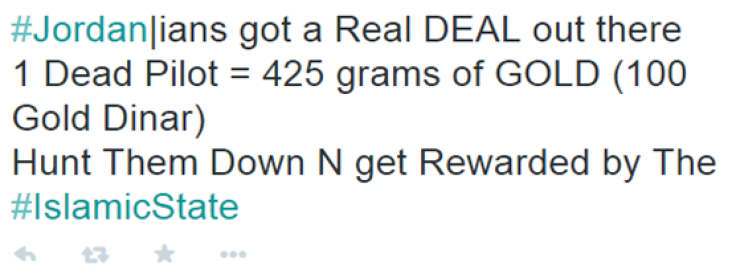Moaz al-Kasasbeh execution: Isis had lone wolf campaign waiting to pounce at Jordanian response
Following the Islamic State's (Isis) 3 February release of Healing Of The Believers' Chests, a video showing the burning to death of Jordanian pilot Moaz al-Kasasbeh, the Jordanian government has vowed an "Earth-shaking" response.
Jordan's revenge, however, which has already involved the execution of two of the country's IS-affiliated prisoners and new air strikes, was anticipated by the terror group.
Evidence of IS's preparation for retaliation from the Jordanian government can be seen in the execution video itself. Throughout the footage, profiles of various pilots are shown, along with their alleged names and satellite images of their supposed addresses among other details.
Furthermore, after it showed al-Kasasbeh's killing, the video promised a reward of 100 gold dinars (around $20,000/£13,000) to anyone who "kills a crusader pilot" on behalf of IS.

Immediately following the video, and subsequent reactions by the Jordanian government, Twitter accounts of IS officials, fighters and supporters echoed the video's offer. For instance, an Arabic-language account, under the name Majeed Elsafouk, tweeted a message using a hashtag translating to "#Kill_Pilot_For_100_Gold_Dinar":
When the conditions are calmed down in two days, take a knife and go to one of the houses of the pilots and stab him in his abdomen whenever you get the chance! Easy
#Kill_Pilot_For_100_Gold_Dinar
Addressing supporters in Jordan, one IS official tweeted:
100 gold dinar to anyone who behead one of the Jordanian pilots.
Get ready, get ready high moral O lions of Islam in Jordan
Others began tweeting screenshots of the video's promise of cash rewards with messages such as "bomb, detonate the tyrants wherever you find them". Another message even appeared to downplay the widespread criticism from other jihadists regarding the Islamic permissibility of burning al-Kasasbeh alive:
Do not be preoccupied with going in depth of the immolation matter :)
Focus on the matter of targeting rest of the pilots
On 4 February, still only hours after the release of the execution video, IS doubled down on its campaign by releasing a statement announcing the bounty from its "General Security Department" in both written and audio form. The statement, repeating the same 100 dinar (or equivalent amount) bounty reward promised and a list of the pilots' names, was an attempt to present the killing of Jordanian pilots as having received the consent of religious leaders.
The message also encouraged others to share "useful information" with which to locate the targets:
Let the opportunity not pass us here to champion our Muslim brothers in Levantine Jordan and incite them to target those criminals who have exceeded the limits with the blood of Muslims, by any possible means, or spread useful information that could facilitate us reaching them.
Subsequent statements from IS fighters and supporters have grown into a swarm of incitements for attacks on pilots, forwarding of the offered bounty, and justifications of attacks within Jordan. Various pro-jihadist Twitter users, including alleged British IS fighter Abu Abdullah Britani, tweeted and retweeted the following message:

This message was also accompanied by screenshots of the aforementioned IS statement of the bounty, and a list of its given names.
The IS-supporting account of Abu Mus3ab almuhajir tweeted:

Similarly, the account of #FreeShamiWitness(س), a reference to the account of an arrested Indian IS supporter named Mehdi Biswas, tweeted:

"If he was here, I would burn him by my hand. I wish to capture pilots and burn them"
The campaign against Jordan did not end there. Almost immediately after the announcement from IS's General Security Department, the group released a video showing a public viewing of the Healing Of The Believers' Chests footage.
During the viewing, an IS interviewer speaks to the people viewing it, one of whom a child who stated of Kasasbeh: "If he was here, I would burn him by my hand. I wish to capture pilots and burn them."

IS's campaign against Jordan is different from its more recent ventures. For one, this would be the first time that the group has ever offered a monetary reward for killing those opposed to it.
Previous calls for lone wolf attacks, such as in France and Canada, promised only the fulfilment of spiritual duty against those the group had characterised as oppressors and kuffar ("disbelievers"). Adding money into the equation shows a new level of investment by IS.
Second to consider is that IS has a significant presence of supporters within Jordan. A poll published in September of 2014 showed that only two thirds of Jordanians even consider IS a terrorist organisation. And, as Jordan borders both Syria and Iraq, the country is at an increased risk of fighters crossing its borders to conduct attacks.
Considering these variables, along with what has been estimated as 2,000-2,500 Jordanians fighting for the group, IS's threats toward Jordan warrant different considerations than those aimed at Western countries.
It is unclear exactly what IS's long-term game plan is. In its recent killings of two Japanese hostages and al-Kasasbeh, added to those nations it has already provoked, the group appears to be firing in all directions of the globe with no sense of tactic - let alone morality.
However, its sporadic methods of operation have made them no less deadly. Whichever way Jordan proceeds in avenging al-Kasasbeh, it should keep its focus inward as much as it does outward.
Rita Katz is executive director of the SITE intelligence group (www.siteintelgroup.com). She has been monitoring terrorist activity and Jihad for more than a decade.
You can find her on Twitter @rita_katz.
© Copyright IBTimes 2024. All rights reserved.






